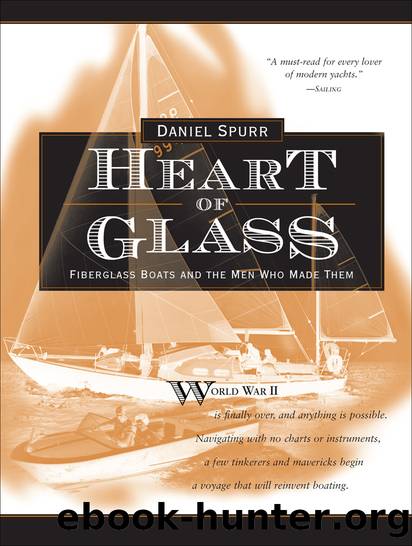Heart of Glass by Daniel Spurr

Author:Daniel Spurr
Language: eng
Format: epub
Publisher: McGraw-Hill Education
Published: 2004-06-14T16:00:00+00:00
Vince Lazzara’s long career in boatbuilding began at Fred Coleman’s AeroMarine in Sausalito, California. Lazzara then moved to Columbia Yachts in Costa Mesa and then to Florida, where he started Gulfstar.
“In 1967 Columbia became a subsidiary of the giant California-based Whittaker Corporation. With the added financial stability, coupled with the technical and engineering resources of its new parent company, Columbia continued to strengthen its position of leadership in the sailboat industry. The company headquarters plant was moved to a 10-acre site in southern California’s Irvine Industrial complex, which to this day is probably the most modern, progressive, and best-equipped fiberglass boat building facility in the country.
“Columbia recently embarked upon a successful kit-boat venture, producing component parts for seven sailing models—ranging in length from 22 to 57 feet—under the Sailcrafter Yachts Kits label. By appealing to the fast growing owner/builder segment of the market, Columbia has significantly broadened its appeal to the yachting public.
“Columbia presently has one of the largest networks of foreign licensees of any U.S. boatbuilder. Under arrangements with leading local yacht builders, Columbia models are now produced in Canada, Australia, Japan, and Spain. Columbia’s impressive record of race wins and its sizeable group of satisfied and enthusiastic owners tells the rest of Columbia’s history.”
Interestingly, this document fails to mention Vince Lazzara who, in 1960, bought controlling interest in Dick Valdes and Maurice Threinen’s Glass Marine Industries after selling AeroMarine to Grumman. Lazzara renamed the company Columbia Yacht Corporation, after the America’s Cup Twelve Meter. He bought the molds of Charley Morgan’s Sabre, which had nearly won the 1964 SORC. It became the prototype of the Columbia 40, which sold well for the new company. And Morgan’s 28-foot Tiger Cub, which had been built “essentially as one-offs,” became the Columbia 31.
Lazzara called Valdes and Threinen “two good fiberglass boys in their early twenties. My main contribution was financial and establishing the dealership organization—I became the distributor for the whole United States. But I was also involved in manufacturing, models, some design … I guess that’s about it.”
Columbia grew and produced new models each year, much like an automobile manufacturer. In addition to Morgan’s 40-footer, there was the 24-foot Challenger and Columbia 24 (1963) that featured the same hull (the former had a flush deck, the latter a conventional cabintop); the Columbia 26 and 29 (1963); and the 32-foot 5.5 meter, an odd, narrow boat that was later called the Sabre but never really caught on. In following years, the company built the Columbia 22, designed by William Crealock; the Columbia 31 (1965); the Columbia Contender; the Challenger; the Defender; the Columbia 38; the Constellation; the Concord; the handsome Columbia 50 (1966), which originally sold for about $50,000; the Columbia 21, 25, 28, and 36 (1968); the Columbia 57 (1969), the largest boat they ever built; the Columbia 34, 39, and 43 (1970); the Columbia 52 (1971); the Columbia 45 motor sailer (1974); and the Columbia T23, T26, 32, and 35 (1975).
THE BILL TRIPP ERA
Columbia 26
The designs of Columbia Yachts
Download
This site does not store any files on its server. We only index and link to content provided by other sites. Please contact the content providers to delete copyright contents if any and email us, we'll remove relevant links or contents immediately.
Sea Survival Handbook by Keith Colwell(1788)
Fatal Storm by Rob Mundle(1783)
Deep by James Nestor(1777)
Breath by James Nestor;(1753)
The River by Peter Heller(1693)
Lonely Planet Australia by Lonely Planet(1666)
Discover Australia by Lonely Planet(1582)
Iced In by Chris Turney(1574)
Lonely Planet Maldives (Travel Guide) by Planet Lonely & Masters Tom(1422)
One Girl One Dream by Dekker Laura(1350)
Ten Degrees of Reckoning: The True Story of a Family's Love and the Will to Survive by Hester Rumberg(1342)
Looking for a Ship by John McPhee(1314)
Lonely Planet Australia (Travel Guide) by Lonely Planet & Lonely Planet(1306)
Chicken Soup for the Ocean Lover's Soul by Jack Canfield(1287)
South with the Sun by Lynne Cox(1218)
The Wave In Pursuit of the Rogues, Freaks and Giants of the Ocean(1214)
Marlinspike Sailor's Arts and Crafts by Barbara Merry(1204)
Diver Down by Michael Ange(1190)
The Golden Rules: 10 Steps to World-Class Excellence in Your Life and Work by Bob Bowman & Charles Butler(1159)
